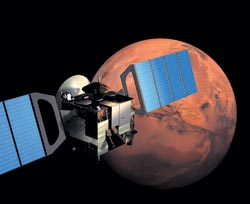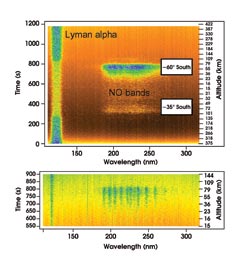Hank Hogan, Contributing Editor
When atmospheres settle down for the night, they glow as photodissociated atoms stream from dayside to night-side and combine in the dark. Scientists analyze this effect, called nightglow, because it reveals facts about atmospheric composition and movement, particularly in the upper atmosphere. Until recently, however, the nightglow on Mars had escaped detection.

Astronomers have detected nightglow on Mars using a spectrometer on the Mars Express orbiter. Courtesy of the European Space Agency.
Now, an international team of astronomers from France, Russia, Belgium, the Netherlands, Finland and the US has spotted martian nightglow using the Spicam UV/IR dual spectrometer aboard the European Space Agency’s Mars Express orbiter. The researchers found the ultraviolet spectrum of the nightglow dominated by NO and hydrogen, which are produced in a process that begins on the planet’s dayside when atmospheric gases are exposed to extreme-UV radiation from the sun.
Jean-Loup Bertaux, the lead author of a Jan. 28 paper in Science describing the results, said that the finding was partly serendipitous. “We were not particularly expecting what we discovered,” he said. “We looked tangentially at the limb in order to maximize the slant path through the atmosphere.”
Spicam features a holographic grating from Horiba Jobin Yvon Ltd. that disperses incoming radiation into a spectrum. This is focused onto an image intensifier made by Hamamatsu Photonics KK, which has CsTe photocathodes and an electron-multiplying microchannel plate. Each photoelectron created at the photocathode is multiplied by the microchannel plate and slams into a phosphor-coated screen to produce a flash of green light that is captured by a Thomson (now Atmel Corp.) CCD.

The UV spectrum of the emission comprises signals from NO and hydrogen produced when nitrogen and oxygen atoms, photodissociated by extreme-UV radiation on the dayside, recombine in the martian night sky.
Bertaux, a research director at the Service d’Aéronomie within the Centre National de la Recherche Scientifique in Verrières-le-Buisson, France, noted that this imaging approach originally was developed by one of the paper’s authors, Bill Sandel of the University of Arizona, Tucson. Bertaux said that the technique displays very high sensitivity because each photon can be detected and that it also offers a very high dynamic range because it is possible to change the gain of the multichannel plate.
Spicam’s UV channel is an imaging spectrometer that produces two outputs. One has a 1.5-nm spectral resolution for wavelengths from 118 to 320 nm, and the second has 10 times the photometric sensitivity but a spectral resolution of only 6 nm. The researchers used both outputs to detect and analyze the nightglow emissions.
They attribute the NO signals to photodissociated nitrogen and oxygen atoms recombining on the nightside. The emission was brightest in the winter night near the south pole. This, they conclude, was the result of the continuous downward transport of air in this region and freezing of the atmosphere at ground level.
As for the future, the scientists plan to observe the martian north polar regions during the local winter nights — this summer in the Northern Hemisphere on Earth. Because of the eccentricity of the Red Planet’s orbit, they predict an even stronger downward flow there than in the south.
Verifying this to be the case is important for a variety of reasons, not the least of which involves future landings on Mars. One technique being considered for such missions is the use of the martian atmosphere, rather than retrorockets, for braking. That could save weight and cost, but it requires a high degree of confidence in one’s models of the atmosphere, Bertaux said.